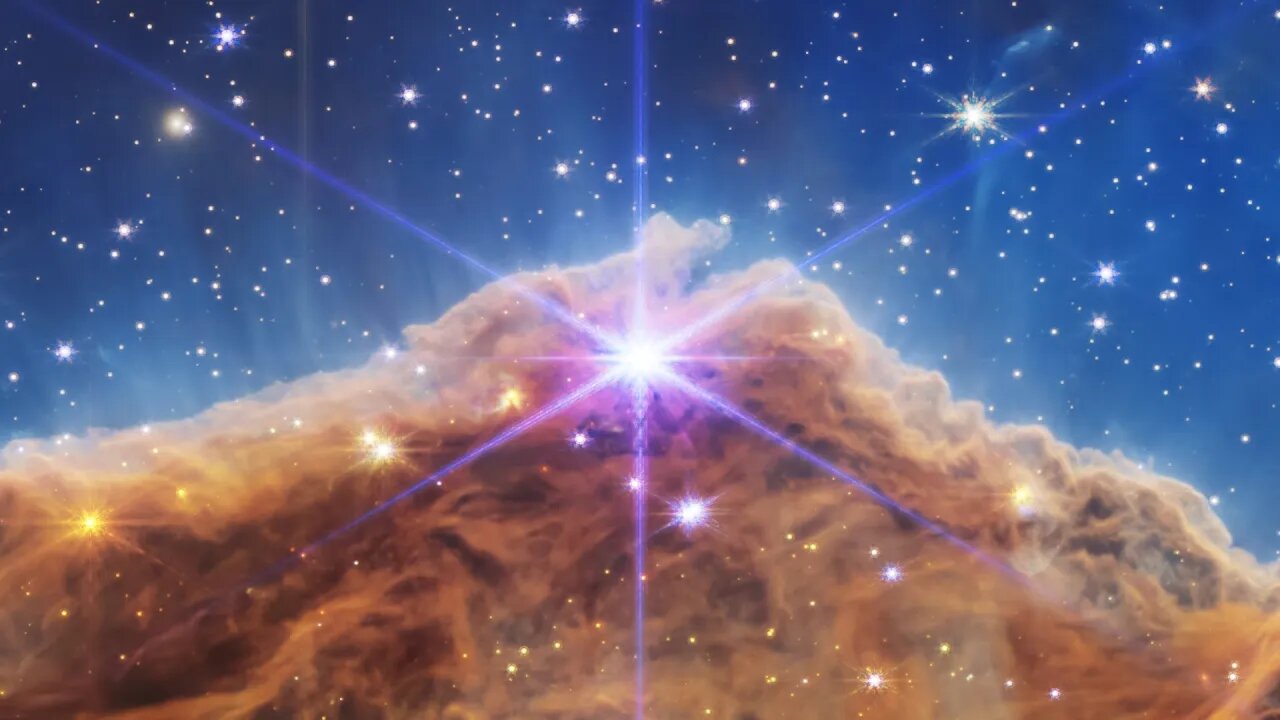Premium Only Content

Som ET - 23 - Stars - James Webb - Carina Nebula (NIRCam Image)
What looks much like craggy mountains on a moonlit evening is actually the edge of a nearby, young, star-forming region NGC 3324 in the Carina Nebula. Captured in infrared light by the Near-Infrared Camera (NIRCam) on NASA’s James Webb Space Telescope, this image reveals previously obscured areas of star birth.
Called the Cosmic Cliffs, the region is actually the edge of a gigantic, gaseous cavity within NGC 3324, roughly 7,600 light-years away. The cavernous area has been carved from the nebula by the intense ultraviolet radiation and stellar winds from extremely massive, hot, young stars located in the center of the bubble, above the area shown in this image. The high-energy radiation from these stars is sculpting the nebula’s wall by slowly eroding it away.
NIRCam – with its crisp resolution and unparalleled sensitivity – unveils hundreds of previously hidden stars, and even numerous background galaxies. Several prominent features in this image are described below.
-- The “steam” that appears to rise from the celestial “mountains” is actually hot, ionized gas and hot dust streaming away from the nebula due to intense, ultraviolet radiation.
-- Dramatic pillars rise above the glowing wall of gas, resisting the blistering ultraviolet radiation from the young stars.
-- Bubbles and cavities are being blown by the intense radiation and stellar winds of newborn stars.
-- Protostellar jets and outflows, which appear in gold, shoot from dust-enshrouded, nascent stars.
-- A “blow-out” erupts at the top-center of the ridge, spewing gas and dust into the interstellar medium.
-- An unusual “arch” appears, looking like a bent-over cylinder.
This period of very early star formation is difficult to capture because, for an individual star, it lasts only about 50,000 to 100,000 years – but Webb’s extreme sensitivity and exquisite spatial resolution have chronicled this rare event.
Located roughly 7,600 light-years away, NGC 3324 was first catalogued by James Dunlop in 1826. Visible from the Southern Hemisphere, it is located at the northwest corner of the Carina Nebula (NGC 3372), which resides in the constellation Carina. The Carina Nebula is home to the Keyhole Nebula and the active, unstable supergiant star called Eta Carinae.
NASA Image: https://stsci-opo.org/STScI-01G7WCK1PJEM49E118GEG0Q729.png
Audio: Som ET - 23 - Stars
Credit: NASA, ESA, CSA, STScI
#NASA #jameswebb #Hubble #ESA #space #science #astronomy #universe #telescope #cosmos #galaxy #nebula #stars
-
 12:19
12:19
Tundra Tactical
12 hours ago $11.79 earnedDaniel Penny Beats Charges in NYC Subway Killing
49.1K10 -
 29:53
29:53
MYLUNCHBREAK CHANNEL PAGE
1 day agoUnder The Necropolis - Pt 1
141K45 -
 2:00:10
2:00:10
Bare Knuckle Fighting Championship
3 days agoCountdown to BKFC on DAZN HOLLYWOOD & FREE LIVE FIGHTS!
49.5K3 -
 2:53:01
2:53:01
Jewels Jones Live ®
1 day agoA MAGA-NIFICENT YEAR | A Political Rendezvous - Ep. 103
138K33 -
 29:54
29:54
Michael Franzese
15 hours agoCan Trump accomplish everything he promised? Piers Morgan Article Breakdown
127K54 -
 2:08:19
2:08:19
Tactical Advisor
19 hours agoThe Vault Room Podcast 006 | Farwell 2024 New Plans for 2025
194K11 -
 34:12
34:12
inspirePlay
1 day ago $5.84 earned🏆 The Grid Championship 2024 – Cass Meyer vs. Kelly Rudney | Epic Battle for Long Drive Glory!
89.9K8 -
 17:50
17:50
BlackDiamondGunsandGear
17 hours ago $3.17 earnedTeach Me How to Build an AR-15
66.4K6 -
 9:11
9:11
Space Ice
1 day agoFatman - Greatest Santa Claus Fighting Hitmen Movie Of Mel Gibson's Career - Best Movie Ever
123K48 -
 42:38
42:38
Brewzle
1 day agoI Spent Too Much Money Bourbon Hunting In Kentucky
83.6K13